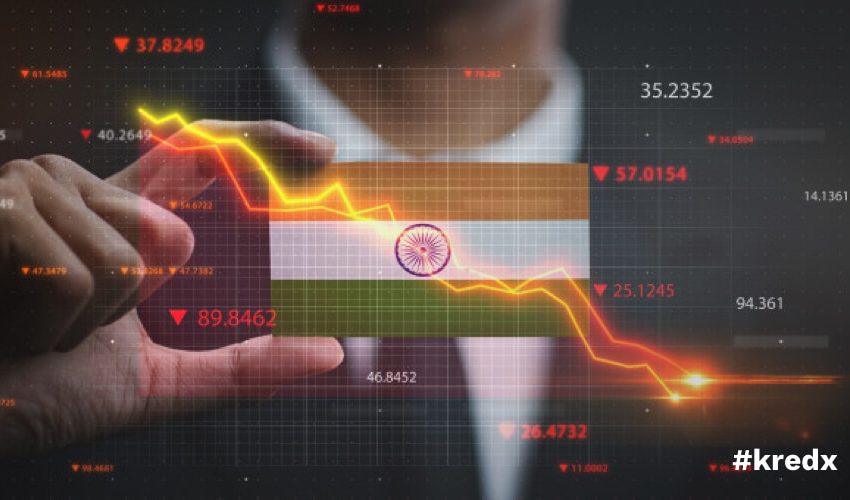
The Impact Of Technical Recession On The Indian Economy
The pandemic-induced economic crisis came as an exogenous shock, creating a multi-sectoral impact and entailing a speculative future for economies and industries worldwide. The pandemic widened gaps in the global political and economic order, which was already faltering under trade wars. Several nations are reeling under the resultant implications of lockdowns and sporadic economic activities. Hit by the massive shock of pandemic, economies worldwide are discovering that the road to recovery is bumpy, and India is no exception. While the staggered re-opening of economic activities and festive season created optimism in the market, negative GDP contraction for the past two quarters has pushed India into a technical recession – an economic condition that is said to occur when there is a contraction of the gross domestic product for two consecutive quarters.
The widespread of the pandemic has accelerated the economic downfall, which was already perceptible before the pandemic outbreak. The GDP contraction of 23.9% in Q1 FY20-21 indicates the extent of the economic downturn due to the pandemic-induced lockdowns and social distancing norms. The quick estimate by the RBI for the second quarter indicates a further fall of 8.6%. As uncertainties continue to loom, developing a robust infrastructure and social capital will likely drive resilience.
An Economic Contraction Like Never Seen Before
India has observed a restraint in its economic contraction in the latest quarter compared to the previous one. The economy has contracted for two back-to-back quarters, given the limitations to control the spread of the pandemic and kickstarting the economy. While supply-chain disruptions and closing of factories and industries reduced the gross fixed capital investment by 47.1%, private consumer spending also plummeted by 26.7%. This, in turn, decreased the amount of global trade which reduced exports by 19.8%, and imports by 40.4% as compared to the former, fundamentally driven due to the falling domestic demand and oil prices. On the industry side, real Gross Value Added (GVA) fell by 22.8% in Q1 FY2020, as all sectors, except for agriculture, forestry, and fishing, were struck due to the nationwide lockdown. RBI projects a negative growth of 7.5% for the fiscal year, even when shrinking of the economy stopped in October and RBI projected 0.1% and 0.7% growths in Q3 and Q4, and these green shoots couldn’t salvage the impacts of Q1 and Q2, where the economy was having a free fall.
However, the rising number of cases, intermittent regional lockdowns have impacted demand, and social distancing norms have kept the economic activity far below the pre-COVID levels. As per a consumer behaviour survey conducted by McKinsey & Company, uncertainties around employment and financial concerns have decreased the spending intent among Indian consumers on discretionary goods. This, in turn, is rendering stifled business investment and delay in hiring, thereby leading to a vicious circle of low supply and demand. Additionally, the prolonged trade war aimed at China and the pandemic outbreak has driven several businesses to amend their investments beyond the Asian supply chains.
Factors That Will Ride The Economy To Recuperation
The way to recuperation will rely upon how long the pandemic endures. The accessibility of treatment and effective deployment of vaccines will be vital, and the sooner people approach both of these, the quicker will be the financial recovery. This is because the spread of the virus is gradually steering to caution and fear. Concern over health, employment, and investments among customers may shift their consumption behaviours and demand patterns. Whereas, businesses may transform their practices, leading to rapid digitisation or embracing agile business models.
Although the supply constraints are easing, the virus outbreak’s implications on the severity of the supply-chain disruptions, business transformations, and capacity building across industries, and financial sector fragility will decide the speed at which industrial production and investment come back to normalcy.
On the domestic front, India’s rural demand may hold up for quite a while due to a decent monsoon and the government’s support to provide employment opportunities in rural areas. However, the increasing number of cases are keeping urban demand subdued.
Technical recessions influence every kind of business, irrespective of its size, given the crushing credit stipulations, slower demand, and fear of uncertainty. While small businesses reel under the threat of corporate consolidation, RBI has urged banks to shell out loans on government’s assurance. Being the backbone of the Indian economy, providing ample financial and infrastructural support to the MSME sector is going to be a key to India’s Atma Nirbhar goal. Besides, regulatory policies like Emergency Credit Line Guarantee Scheme (ECLGS), Fund of Funds, and distressed asset funds are expected to bring some relief to the MSME sector.
Bottomline
Facing such an unprecedented circumstance that has led to an economic slump, India needs to evolve into an economy that shows fiscal flexibility. However, relatively large market size is expected to attract foreign investments – a key to India’s “self-resilient” vision. To boost demand, disposable incomes need to be stepped up through various financial measures. India’s goal of creating a self-reliant economy should be rendered as a means of building a robust domestic economy through investment and consumption demand, thereby leading to a favourable business environment and economic growth.



